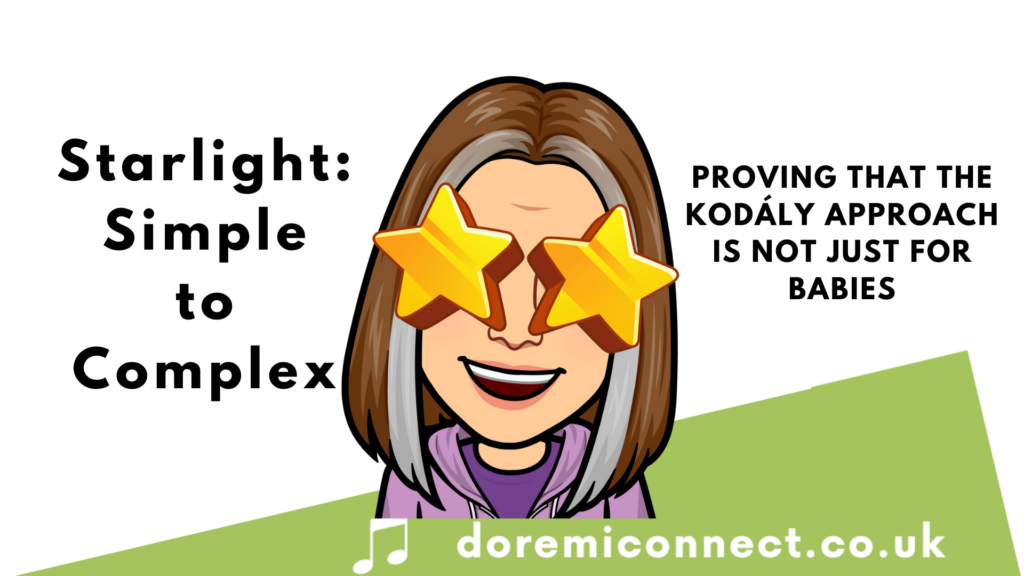Starlight: Simple to Complex

I just love taking really simple songs that we can use multiple times throughout the journey of students musical education and give them different learning opportunities from simple to complex and thus proving that the Kodály approach is not just for babies; it is can also really can provide very challenging activities for older children, teenagers and even adults!
There are couple of Kodály inspired activities in here I think you should try yourself. See how you get on!
Here’s the song I’ll be using to show you what I mean:
You probably know this song but you might have heard it with a different melody. There are a number of different melodic settings for these lyrics. Listen to the recording above to hear the melody I use. I LOVE using this version with the little ones in years 1 and 2 (ages 4-6).
Kodály inspired musical concepts for our students
We can use it to:
- introduce lullabies and the idea of soft singing.
- get them to rock their baby to the beat – it’s no good rocking to the rhythm, that baby isn’t going to go to sleep!
- develop soft singing,
- develop an understanding of dynamics, in particular, piano which we’ll later contrast with forte.
- subconsciously introduce phrases – we have actions for each phrase. The change of action at the end of every phrase means they can feel that there are four 4 beat phrases in the song. We won’t talk about it yet, but it’s there for later.
A Beat vs Rhythm Microstep...
We can also use it for pitch development of so and mi. I use it with my singing classes, in the classroom, with my piano students and even adult students! I also like this one for teaching beat and rhythm. Once we know our rhythm names, while rocking a pretend baby we can say:
Ta ta ta ta
Ta titi titi ta
Titi ta titi ta
Titi titi titi ta
Keeping the beat going while rocking the baby and saying the rhythm names at the same time is a great beat vs rhythm microstep. We can develop it by clapping the rhythm as we’re rocking, eventually moving towards tapping the beat with one hand and the rhythm with the other. When one of my students managed to do it he was so excited and happy! This is why we do it isn’t it!
Back to rhythm… the fact that we have four phrases is very interesting because each of the four phrases have a different rhythm. This means we can use it for supported dictation. Traditionally in dictation, you listen to a piece of music you don’t know, someone sings something or someone plays it on an instrument and you have to scribble down what they play. We can do that with this song but if they know the song already, we’re being a bit more supportive by singing it to them so they have the memory of the song in their mind. This means they’re more likely to succeed. It’s still dictation; we’re taking a sound and turning it into a written piece of work.
Linking Rhythm to Phrasing
The other thing we can do to support our students even more is think about the fact that the four phrases have four different rhythms. We could work out the rhythm for each of the phrases but maybe you’re not getting them to work them out to start with, maybe you’re just asking them to put them in the right order. Jumble up rhythm flashcards for each phrase for our students to them in the right order – that’s also dictation!
With my piano students, after looking at the flashcards, we go to the Sing and Play Piano book, I clap one of the phrases and they have to say which one it is. Another form of dictation!
Something more complex for us teachers!
This might be easy for you, so let’s give you something to develop your musicianship skills…
Play the audio clip of Starlight above and see if you can sing the song and tap the rhythm in canon with me singing 4 beats later, so you’re tapping the rhythm of the first phrase while I’m singing the second phrase.
This is step one! Step two is to sing Starlight yourself and tap in canon 4 beats later.
How did you do?
Good? If not, practice practice!!
While tapping the rhythm in canon, we’re hearing the song, pitch and lyrics so developing our two-part hearing.
If you want an extra challenge you can do the same thing while singing it in solfa or use the rhythm names.
Or you can sing it in solfa and sign the solfa in canon!
Elevate Starlight to intergalactic levels!
Another wonderful you can do with this song (and a lot of the other fairly simple songs that have so mi and la) is to find gorgeous contemporary chord sequence to play underneath. So many work! If you’re not confident at making up your own chord sequences, find a pop song, ballad or piece of musical theatre… This is Me chord sequence is quite good to go with it. You can change it a bit to make it your own and improvise using that chord sequence against the melody of Starlight.
Definitely definitely NOT babyish!
Want more advice and ideas?
If you found this blog useful. Please comment below if you did or if there is anything you would like to say to me about it. If you’d like to find out more about preparing your students to learn about pitch and much more, including over a year’s worth of lesson plans for teaching all the important musical skills with Helen’s clear microsteps, why not try out Doremi Membership for 14 days for just £1?
[…] you missed Starlight Star Bright, take a look at my blog post to catch […]